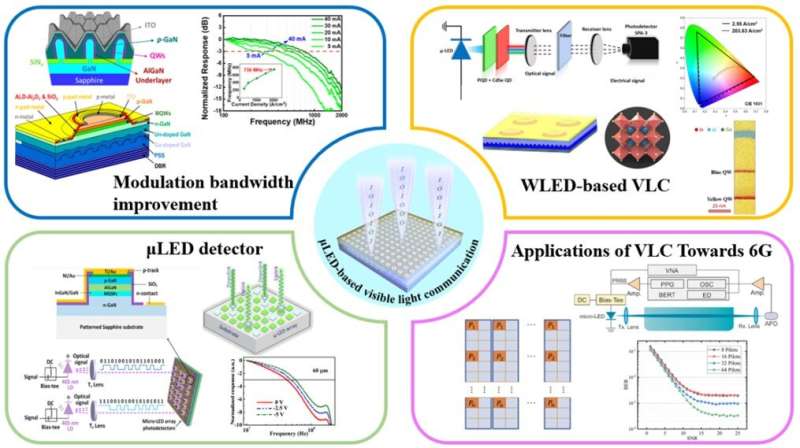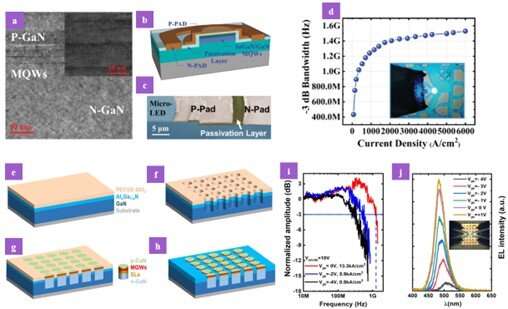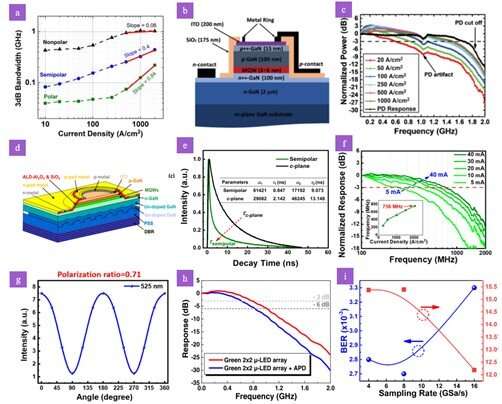This article has been reviewed according to Science X's editorial process and policies. Editors have highlighted the following attributes while ensuring the content's credibility:
fact-checked
proofread
Highspeed visible light communication based on micro LEDs

The evolution of next-generation cellular networks is aimed at creating faster, more reliable solutions. Both the next-generation 6G network and the metaverse require high transmission speeds. Visible light communication (VLC) is deemed an important ancillary technology to wireless communication.
Light-emitting diode (LED) solid-state lighting technology offers low power consumption and cost, small size, and a long operational lifetime. Moreover, it is environmentally friendly. These advantages contributed to the explosive growth of the LED-lighting market.
Notably, the visible-light band with a spectral range between 380 and 780 nm is not licensed like radio frequencies and can be used without authorization. Hence, LED-based visible light communication (VLC) technology has attracted research attention worldwide, and VLC technology has rapidly developed in the past decade.
The flickering of LEDs cannot be identified by the naked eye, owing to the high frequency of the signal in the VLC system. Thus, by adding relatively inexpensive front-end components, VLC can be easily implemented in existing lighting infrastructures to achieve data communications with speeds in the Gbps range.
Furthermore, compared with the considerable co-channel interference of wireless RF communication, the propagation of visible light is not perturbed by electromagnetic waves, i.e., the electromagnetic interference phenomenon does not occur. Therefore, VLC offers unique advantages in hospitals, airports, nuclear power plants, underground mines, substations, and other scenarios that are sensitive to electromagnetic interference.
Owing to high modulation bandwidths of micro light-emitting diodes (μLEDs), they are ideal light sources for high-speed VLC. Although μLEDs are now widely used in VLC, few studies have provided general descriptions of μLED-based VLC systems from devices to applications.
The authors of this article present an overview of μLEDs for VLC. Methods to improve the modulation bandwidth are discussed in terms of epitaxy optimization, crystal orientation, and active region structure. Moreover, photoluminescent white LEDs based on phosphor or quantum-dot color conversion and μLED-based detectors for VLC are introduced. Finally, the latest high-speed VLC applications and the application prospects of VLC in 6G are introduced.

As the most common type of μLEDs, structural optimization of c-plane μLED devices has been reported and the improvement of the modulation bandwidth has mainly focused on enhancing the carrier recombination process. The specific methods include the formation of metal contacts with low contact resistance by thermal annealing, the growth of ultra-thin QW devices, etc., which can significantly improve the modulation bandwidth of μLED devices.
Furthermore, C-plane LEDs are affected by a strong quantum confinement Stark effect (QCSE), which limits the modulation bandwidth. One approach to overcome the QCSE is to fabricate nonpolar or semipolar structures. The modulation bandwidth of μLEDs with different crystal orientations is shown. The bandwidth of μLEDs grown on the nonpolar faces is the highest, followed by the semi-polar plane and c-plane. Therefore, manufacturing non-polar or semi-polar μLED is also a method to improve the modulation bandwidth.
Due to their low power consumption, high brightness, high resolution and color saturation, μLEDs are advantageous for display and lighting applications. Therefore, white-light VLC systems based on μLEDs can achieve both illumination and display functions in addition to high-speed data transmission, which has greater application prospects. The authors of this article have compiled the latest advances in μLED-based white-light VLC systems in recent years to demonstrate that these kind of systems are expected to become an important part of next-generation communication and illumination technologies.

As the research on μLED devices expands, the μLED-based high-speed VLC is garnering increasing interest. This review summarizes the advantages and challenges of μLEDs in VLC systems. Methods to improve the modulation bandwidth of μLEDs were introduced. In addition to conventional c-polar epitaxial structure optimization and semi/nonpolar GaN epitaxial growth, μLEDs using microstructures or InGaN QDs as active regions can also improve the radiative recombination rate.
μLEDs are considered bright solid-state lighting sources compared with different classes of WLEDs for VLC. Similarly, μLEDs can also be used as detectors in VLC systems. Finally, the prospects of VLC in 6G and the latest high-speed VLC applications were introduced. Given the high-speed transmission advantages, μLED-based VLC is expected to become an ancillary technology for 6G and cooperate with other communication technology to benefit our daily lives.
This work provides new ideas for the device design of high-bandwidth μLEDs, reveals more potential uses of μLED-based high-speed VLC systems, and provides a new technical path for the promotion of VLC in next-generation communication technologies.
The research is published in the journal Opto-Electronic Science.
More information: Tingwei Lu et al, High-speed visible light communication based on micro-LED: A technology with wide applications in next generation communication, Opto-Electronic Science (2022). DOI: 10.29026/oes.2022.220020



















